by Claire Chambers
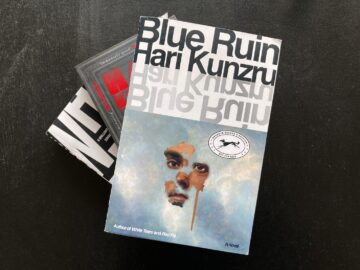 Introduction
Introduction
Hari Kunzru has recently completed the third novel in his three colours trilogy about race, class, and the arts. White Tears concerns music and was published in 2017. Red Pill deals with literature and came out in 2020. And Blue Ruin zeroes in on fine art, having just been released last month, in May 2024. All of the novels examine racism and evoke various upheavals in the present moment. The titles of this tripartite sequence of novels figure forth the American or British flag, signifying the fractured state of these nations. Paul Gilroy rightly claimed in the title of his 1987 book that ‘There Ain’t No Black in the Union Jack’, and Kunzru’s storyworld also highlights the strife amid the stars and stripes.
In this essay, I am interested in how a sensory studies perspective can enrich discussions of Kunzru’s trilogy. I discuss sound (and, to a lesser extent, touch or its absence) and a need to listen to other voices. The key issue here is whether, and to what extent, the tolerant should be tolerant of the intolerant. In White Tears, Red Pill, and Blue Ruin, Kunzru makes a conscious effort to listen to the repugnant politics of white supremacists, alt-right provocateurs, and QAnon or ‘plandemic’ conspiracy theorists. Trying to understand their views without either endorsing or criticizing them (while subtly forming judgements), Kunzru trains his ear on loathsome conversations and does some radical listening.
White Supremacy and the Blues
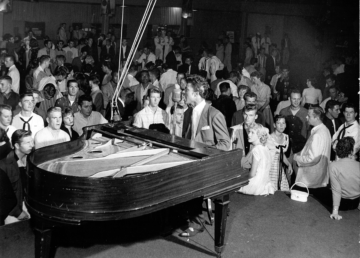
White Tears deploys the perspective of a first-person narrator who is something of an outlier when it comes to the objectionable views being portrayed. This protagonist Seth is white, poor, and he lost his mother and (relatedly but temporarily) his sanity while still at high school. Now he is a young man, a geeky music technologist living in precarious circumstances. He is fascinated by noise, passing his time by compulsively recording city soundscapes to create a sonic map of modern New York. We are told: ‘I collected audio of thunderstorms, music coming out of cars, the subway trains rumbling underfoot’. To his own amazement, he gets swept up in an elite, Waspy world, becoming friends with the equally musically-minded Carter Wallace and (more reluctantly on their part) involved with Carter’s beautiful sister Leonie and their old-money Republican family. Of the trilogy, this is the novel that blends the politics of listening with actual sound most directly.
Kunzru’s hallucinatory book is all about blues music, which genre’s vibrations reverberate ‘into the past, into the future’. But Carter and his counterparts from the novel’s strand set in the 1950s and early 1960s – namely, the collectors Chester Bligh and JumpJim (the latter surviving into the digital age, when his online name is drawn from a minstrel character) – look selectively at the past, emptying out this musical style of its painful African American history. Carter, readers are informed, ‘listened exclusively to black music because, he said, it was more intense and authentic than anything made by white people’. Yet he has only a ‘garbled explanation [for] the source of this black intensity’, failing to mention slavery, the South’s antebellum period, or the later fight for civil rights. This is what Rupa Marya and Raj Patel in a different context call the ‘invisibilis[ation]’ of black pain. This selective vision is unsurprising, for the Wallace family’s success was built on exploiting the labour of African American convicts in the Deep South.
Carter teaches Seth to be slightly ashamed of his white inauthenticity, covering up for it with ‘a sort of professorial knowledge’, encyclopaedic yet depthless, about the blues. The two of them feel jealous of the Black students at the university for their effortless fidelity to and yet lack of interest in the musical category. They fetishize a Nigerian classmate because he wears his hair in dreadlocks and looks like old-time singers. However, ultimately they are uninterested in Black people or their real-world struggles against structural racism. Instead these white youngsters are drawn to ‘those old songs, those disembodied voices rising up out of the past’, seeing the tunes as ‘a refuge from the world’. His racism even more engrained, the older music aficionado JumpJim hopes such songs will never be ‘contaminated by current affairs’ or ‘the condition’ of African Americans.
Carter is a hipster who rejects the modern, deleting his iTunes to listen only to records, as Kunzru astutely and satirically limns the obsessive mundanity of the white male collector. To impress this cool co-student, Seth follows suit, abandoning the modernity of the clinical techno he used to love, and instead championing old records, with all their hiss and crackle. The two young men set up a recording studio and have some triumphs, producing successful songs for a white American rap star and a British band in the mould of the Rolling Stones. The issue of cultural appropriation and of Black music being exploited by white people is thus foregrounded.
The two men create a fake record, or at least a work of stolen sound art, by an artist supposed to be from the Jim Crow period whom they conjure up and bestow with the name Charlie Shaw. Online, they upload a rendition of the song infused with a deliberately tumultuous and distressed style. This manipulated track garners much acclaim from collectors who deem it a forgotten classic. Yet rather than basking in their success, the two men begin to feel shadowed by the spectres of blues music. They find themselves in the midst of ‘audible ghosts’, which haunt the contact zone of online life with their analogue suffering. It turns out that Charlie Shaw could be a real African American, albeit one with a ‘far from fixed’ identity, who was murdered by white people before he was ‘able to record the record that never was’. Conversely, as we will see shortly apropos of Red Pill, this could all be paranoia – everything is ambivalent and nothing certain. The only solid thing in the novel is the structure of the music, which itself might be creating these phantoms. Music, Seth believes, ‘can put the listener in a room that doesn’t exist, that couldn’t exist. [It] can put them in an impossible room’. This leads to unsettling questions about reality and perception, central to the novel’s exploration of musical hauntology.
Red Rage and Writing the Alt-Right
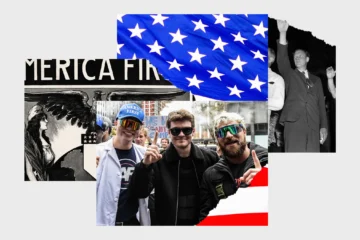 Kunzru’s Red Pill shares some similarities with White Tears, given its colourful two-word title and the fact that it is also relayed in the first person by an outsider. The narrator is an Englishman usually based in New York who is now on an extended stay in Germany. His interstitial status is further indicated when we learn that his father is Indian while his mother is white English. This adds a layer of autofiction to the narrative, although readers are told nothing about either the patriarch’s immigrant experiences or his marriage to the narrator’s mother.
Kunzru’s Red Pill shares some similarities with White Tears, given its colourful two-word title and the fact that it is also relayed in the first person by an outsider. The narrator is an Englishman usually based in New York who is now on an extended stay in Germany. His interstitial status is further indicated when we learn that his father is Indian while his mother is white English. This adds a layer of autofiction to the narrative, although readers are told nothing about either the patriarch’s immigrant experiences or his marriage to the narrator’s mother.
The novel is an absorbing, multilayered exploration of writer’s block, German Romanticism, the so-called refugee crisis, and one man’s psychotic break in the lead-up to Trump’s election victory in 2016. Also critically listened to are far-right figures from history; the omnipresence of surveillance; and the murky depths of the alt-right, meme creators, and the manosphere. In this intangible yet energizing novel, Kunzru stirs together a combustible mix of paranoia, visual imagery, and cultural commentary.
I contend that a sound studies approach to this fictional work is revealing. Although this is a text through which we share the hypervigilant narrator’s obsession with eyes, the gaze, spying, voyeurism, and surveillance, at the novel’s heart is a strange vignette about sound and music. At one point the narrator thinks: ‘Everything is Ruh, a deep and ancient word, rooted in the Iron Age. It is the word for the absence of sound, but also for spiritual rest’. Here Kunzru probably alludes to the languages of Arabic, Persian, and Turkish. All of these cultures were thriving up to about 500 BCE before European colonialism, although in truth their word ‘Ruh’ (روح) probably predates the Iron Age. The term is typically translated as ‘spirit’ or ‘soul’, but connecting it to a profound silence or stillness that brings inner peace indicates Kunzru’s interest in the unheard and undocumented. No wonder that for most of the novel there is a notable absence of sound. Only the punk segment (which I will analyse later) is saturated with noise. Kunzru, like his pre-medieval antecedents, experiments with silence.
Our unnamed narrator is participating in a writer’s retreat, the Deuter Center, at Wannsee in southwest Berlin. Here he battles creative paralysis as he tries to write a monograph about lyric poetry. He resents the sanctuary’s open research principles, which require him to eat communally and share a workspace with other authors. Because his internet-surfing rather than writing would unleash another resident’s intellectual superiority complex, he finds the coworking especially excruciating. Adding another autofictional layer, Kunzru himself had been Fellow of the American Academy in Berlin during 2016. The novelist takes pains to note in his Acknowledgements that all these two institutions share in common is their location.
The narrator starts to believe that there are cameras in the rooms watching the scholars’ every move. This is a distortion of the panoptic gaze of what Shoshana Zuboff has termed ‘surveillance capitalism’ in our digital age. The concept of the panopticon, Bentham’s and Foucault’s architectonic and disciplinary model of social control, lurks in the margins of Red Pill. Kunzru unpicks the idea of digital devices as a modern-day panopticon, since online activity is monitored, collected, and monetized. This notion of constant surveillance draws eerie parallels with the oppressive regime of East Germany, where the Stasi’s prying eyes constrained the lives of citizens.
‘surveillance capitalism’ in our digital age. The concept of the panopticon, Bentham’s and Foucault’s architectonic and disciplinary model of social control, lurks in the margins of Red Pill. Kunzru unpicks the idea of digital devices as a modern-day panopticon, since online activity is monitored, collected, and monetized. This notion of constant surveillance draws eerie parallels with the oppressive regime of East Germany, where the Stasi’s prying eyes constrained the lives of citizens.
In Red Pill, Kunzru arranges the collision of two very different worlds – the quiet, art-focused realm of humanities research and writing, and the menacing domain of the far right. This clash recalls the turbulent 1930s in Germany, a decade regularly evoked in the novel, when intellectual and cultural elites failed to stem the rising tide of extremism. Kunzru deftly incorporates real-world elements, such as the contemporary arts scene, the influential work of Ai Weiwei, and the German response to incoming migrants. The privileged domain of a writer’s retreat contrasts with the grim hardships faced by refugees. As the narrator’s mental health starts to unravel, a father and daughter he sees scavenging for food from a dustbin, and later unwinding in a frenetic charging cable-laden refugee camp – this camp ‘a world of noise’ – make him feel guilty about his own peaceful affluence.
The novel takes a hard look at contemporary political landscapes and the red pill of digital hatred. Kunzru represents the reactionary Blue Lives Matter movement through Gary Bridgeman, the charismatic creator of a fictional cop series Blue Lives, which the narrator is binge-watching instead of writing his book. This creator and director, known to his friends for mysterious reasons as Anton, is a fictional figure whose showmanship and sardonic ideological embrace of Nordforschung, research about ‘the idea of North’, parallel the rise of amoral and often racist populist influencers on platforms such as YouTube and TikTok. Anton’s literary allusions, including references to Joseph de Maistre’s conservative works, add an intellectual patina to the police procedural. The narrator feels compelled to engage with some of these philosophical attempts at lending legitimacy to authoritarianism and extremism.
When the two men meet in a random encounter, this allows the novel dissect ideas about race further, with Anton making troubling comments about racially othered people and the supposed emasculation of liberal men. Kunzru’s exploration of this theme is uncomfortable and incisive, as he urges readers to recognize the insidious nature of new incarnations of long-standing racism.
Anton invites the half-Indian protagonist to eat with him and his friends at an unpretentious Turkish restaurant. There he confronts hackneyed Islamophobia and anti-Turkish hatred, but also a racism 2.0 which is jokey, self-referential, and partially withholding. ‘Come inside or stay in the dark’, Anton intones, poker-faced but with an arch timbre. Our narrator reflects: ‘So much of what he said had that particular tone, that suggestion of double meaning. Come inside or stay in the dark, as if he were about to initiate me into a mystery, offer me the red pill’. The alt-right flourishes amid such language, which could be ironic but is definitely coded. In the context of certain far-right online communities, the term ‘red pill’, drawn from the 1999 film The Matrix, is often used metaphorically to refer to a person’s awakening to what they see as the harsh realities of the world, particularly in relation to crude notions concerning ethnicity, gender, and politics. Indeed, once he is gripped by delusional ideation about Anton, the narrator thinks: ‘I was living and moving in a matrix entirely designed by him’. Even if the world is no simulation and thus Anton cannot be its architect, the narrator is right to look for the bigger systems that from within his information silo seem almost invisible.
Kunzru employs a fissured and disjointed narrative style, with the lyric I spiralling into the abyss of psychosis. This is the most brilliant portrayal I have ever read, as an ex-sufferer of postnatal psychosis myself, of the way psychotics seize at coincidences and perceive grand patterns in the world where none exist. To me, it’s far more persuasive than Salman Rushdie’s depiction of Gibreel Farishta’s schizophrenia in The Satanic Verses, for example.
Part of the narrator’s anguish stems from the ‘state of the world’ and the ‘new dispensation’ that he senses even before the 2016 election. His fragmented sense of self acts as a funhouse mirror for the disintegration of social norms and values typified by Donald Trump’s win over Hillary Clinton. The narrator expresses his terror over the apocalyptic zeitgeist, the ‘plagues and melting glaciers and drowned cities and millions of people on the move’. The new world order is, he thinks, ‘a system that would eventually find itself able to dispense with public politics altogether and put in its place the art of the deal’. Trump disregards democracy and disdains art, instead promoting ‘the art of the deal’ – the title of his best-known book – while privileging an individualistic and business-oriented nihilism. As we stare down the barrel of a possible second presidency, the narrator’s belief that Trump ‘is a gate, a portal through which all manner of monsters could step into our living room’ appears realistic rather than psychotic.
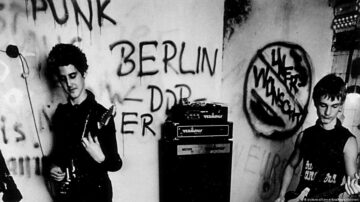 Witnessing the narrator’s mental distress, the cleaner who tidies the narrator’s increasingly chaotic and putrid room at the Centre has a story for him. This woman, Monika, tells the protagonist about her experiences playing drums for a band in the East German punk scene up to the fall of the Berlin Wall in 1989. (Interestingly, ‘Never Mind the Stasi’, an episode from Kunzru’s podcast Into the Zone, provides thorough discussion of this anarchic milieu.)
Witnessing the narrator’s mental distress, the cleaner who tidies the narrator’s increasingly chaotic and putrid room at the Centre has a story for him. This woman, Monika, tells the protagonist about her experiences playing drums for a band in the East German punk scene up to the fall of the Berlin Wall in 1989. (Interestingly, ‘Never Mind the Stasi’, an episode from Kunzru’s podcast Into the Zone, provides thorough discussion of this anarchic milieu.)
Red Pill invokes a visceral sense of punk. When Monika comes across the music and fashions for the first time, it is ‘like being electrocuted, jolted out of her dead skin’. Snake-like, she sloughs off her previous encasement as a mousy if reluctant rule-follower in the German Democratic Republic, spiking up her hair to join two other disaffected young female musicians in a band they name Die Gläsernen Frauen or The Transparent Women.
They scream-sing about the male gaze: ‘You want to look? | Go ahead | Go ahead | Are you happy now?’. From being surveilled and pellucid, a glassy pane through which the GDR’s authoritarian policies can be projected, Monika has been transformed into a subversive drummer who generates an unadulterated non-verbal cacophony. Her first gig is described as follows:
There wasn’t a stage, they just walked out into silence, some scattered clapping. And then they attacked. One two three four, into their first number, which was just Katja shouting ‘Stupid bear! Stupid bear!’ while Elli played some chords she’d copied from a Ramones song. […] She battered her kit and it sounded like dead bodies hitting the ground and the guitar and the vocal fed back so the whole thing was just a mess of distortion, you couldn’t say what it was, or if it was music exactly, but it had something. Energy. Life.
This passage summons the power of music, even accompanied by virtually meaningless lyrics, to electrify an audience. The band defies preconceived ideas about melody in spite of their derivative chord structures. Kunzru highlights pop music’s elements of surprise, violence, and the allure of rebellious nonconformity.
As such, although visual imagery takes precedence over the auditory in Red Pill, a space is cleared at the core of this watchful novel for a pogoing group of young East German punks. The group is ultimately defeated, splintering because of surveillance through sound more than the gaze. It transpires that one of the band’s members has been spilling out all their secrets to the eagerly-listening Stasi. Monika ends up imprisoned, coercively controlled, and broken in a way that the paranoid but privileged narrator finds difficult to imagine.
To conclude this section, as Kunzru’s novel traverses the porous boundaries of reality and imagination, so does the writer’s block that plagues its protagonist blur the line between creativity and despair. These thematic threads are stitched into the overarching hoop of Nazi-era Germany, a time when the world teetered on the precipice of chaos, not unlike the binaristic, fascistic contemporaneity depicted in the novel. Kunzru is right to say ‘there’s a Weimar feeling’ to the rise of populism that became particularly visible from 2016 onwards. Red Pill scrutinizes the far right from an appalled observer’s standpoint, as the first-person narrator finds himself increasingly deluded that he and Anton are locked in some existential battle over the Earth’s future.
Ruinous Pandemic Blues in the Artworld
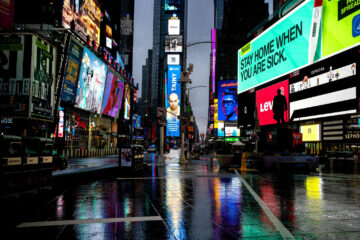 In the third novel of this loose trilogy Kunzru sketches the contours of social inequality, racial divisions, and the pandemic’s residues in today’s world. Partly set in May 2020 amid a Covid-ravaged New York state and partly in London’s 1990s art scene, Blue Ruin is as much an exploration of artistic vision as it is a story about identity, health, and wealth.
In the third novel of this loose trilogy Kunzru sketches the contours of social inequality, racial divisions, and the pandemic’s residues in today’s world. Partly set in May 2020 amid a Covid-ravaged New York state and partly in London’s 1990s art scene, Blue Ruin is as much an exploration of artistic vision as it is a story about identity, health, and wealth.
Kunzru portrays inequality through his divided cast of characters. The first-person narrator, Jay, is a mixed-heritage British man who used to be an artist but now lives a precarious existence as an undocumented migrant in the United States of America. Working in the gig economy delivering food in New York state for a faceless app, Jay has already caught the novel coronavirus and is still recovering. This precarity is juxtaposed with characters who work in the more desirable ‘creative economy’. These creatives’ economic stability and the fickle circulation of their work seems decadent by comparison with the key workers, yet art can nonetheless offer sustenance. Such solace is needed because harsh class divisions and the fragility of systems and societies are becoming more apparent in this ‘pathogenic’ period.
The novel opens with an exhausted and feverish Jay doing a grocery dropoff at an palatial yet understated home in the countryside. He soon realizes that this is the lockdown residence of his ex-girlfriend Alice. Twenty years ago Jay and Alice had been living together in London when she ran off with his best friend and fellow painter Rob. Now long married, Alice and Rob are seeing out the pandemic at this house as part of an uneasy ménage à quatre with the white American gallerist Marshal and his ‘trophy’ African American girlfriend Nicole.
Jay’s long Covid means he is in no fit state to leave and get back to his supply rounds, so for a time Alice manages to hide him away in a barn outbuilding to recover. Kunzru wrongfoots the conceit of a racialized intruder entering an isolated house. Their secret will out, though. Soon Jay faces violent altercations from within a noir generic framework, first with the distrustful, conspiracist, and far-right leaning Marshal and then with jealous and predatory Rob. These men’s actions of pointing guns at a racial other is wearily summarized by Nicole as just ‘another white man wanting to burn down the world to salvage his fragile ego’. As tensions escalate, Jay’s presence disturbs a weak harmony between cohabiting strangers and shows how quarantining is a racialized luxury.
Kunzru adumbrates some of the spatial and temporal disruptions caused by the pandemic. Marshal and Nicole have only been in a relationship for six months, their decision to move in together, like that of so many other couples, having been ‘accelerated’ by Covid protocols. Despite shared interests in art and wellness, their differing attitudes to race inequality makes them uneasy bedfellows. Marshal has spent too much time online during lockdown. He harbours doubts about the virus’s zoonotic origins, instead buying into lab-leak theories or even blaming a Chinese bioweapon. This provocation upsets Alice, as she is half-Vietnamese and reminds the others of racist attacks against people who look East Asian amid what is being dangerously calumnized by President Trump and others as a ‘Chinese virus’. Kunzru’s narrative explores pandemic-fuelled relationship issues, racial tensions, and conspiracy theories shaping the strangely elastic time of the first lockdown.
The novel is unflinching in its figuration of the physical as well as mental toll of the virus, portraying bodies both as feared vectors of disease and sites of resistance and endurance. On their first reunion, Alice shies away from touching a visibly sick Jay, snapping, ‘I really can’t catch this thing’. She and, later, the others are gradually reassured by Jay’s negative test and the fact that he first experienced symptoms two months earlier. He nevertheless finds it difficult being ‘seen as a threat all the time’. Jay has to contend with a world where human touch is fraught with danger and social distancing warps relationships, overlaying old modalities of segregation with new ones. What’s more, the aftermath of this crisis has been thrown into doubt, with Alice asking Jay: ‘You think there will even be a future? I’m not sure’. Kunzru exposes the struggles 0f poor people of colour such as Nicole’s grandmother and Jay himself regarding medical insurance in the US, a nation where healthcare is commodified.
The human body is generally taken for granted but becomes obtrusive ‘when it didn’t do what [people] wanted’. Drug abuse, manual labour, and ageing have lent pronounced ‘knots and scars’ to Jay’s physicality. After Covid he feels ‘present in my body, in that way you only ever notice when you’re recovering from an illness’. Different from Jay’s corporeal degradation, Alice’s body consists of ‘yoga and massage and raw juices and money’. Moreover, if anything does go wrong with Alice’s health, ‘people in her world had insurance’. Kunzru’s portrayal highlights the isolation imposed by the pandemic and stark inequalities in health access.
As in the earlier novels of his trilogy, the author orchestrates a collision between two ‘different worlds’. In this case, it is the ostentatious, fashionable realm of fine art versus the precarious domain of the undocumented. Even within what Kunzru calls the ‘artworld’, there is a striking lack of ‘equity’. When he was still a part of that world, Jay had taken it upon himself to expose such disparities. But he has long since disappeared from those circles, so Marshal expresses elitist amazement that Alice had once ‘date[d] the delivery guy’. When he realizes that this ‘basically homeless’, ‘illegal’ man is the celebrated ‘Jason fucking Gates’, Marshal is full of regret, bewailing: ‘I wouldn’t have approached it like that if I’d known who you were’. Clearly, some bodies (somebodies) are worth a lot more than others in this society.
Hierarchies become even more stratified during the pandemic, in which impoverished people like Nicole’s grandma are dependent on ‘furlough’ payouts, even as others such as Alice use the virus as a ‘fig leaf’ to lay off employees. Meanwhile Marshal hoards a wealth of protective equipment that ‘hospitals don’t even have’. Like Jay, Kunzru critiques systemic inequality, showing how various bodies are valued or devalued in Anglo-America.
Racial injustice is portrayed somewhat tangentially and with controlled anger in Blue Ruin. Jay’s full name, Jason Gates, is only revealed more than halfway through. He inhabits a white world that frequently disparages his mixed-heritage identity. The eventual disclosure that Kunzru’s protagonist is biracial (white English and Black – probably Jamaican) gestures to broader motifs of racial identity. Jay never gets to know his Black father but, during an unhappy childhood, he suffers abuse from his white stepfather, Douglas. Jay notes balefully that his own existence, a reminder of his mother’s fling with a Black man, gives Douglas the ‘whip hand’ over Jay’s mother. This phrasing immediately reminds many British readers of Conservative politician Enoch Powell’s 1968 ‘Rivers of Blood’ speech and the way it emboldened racists like Douglas.
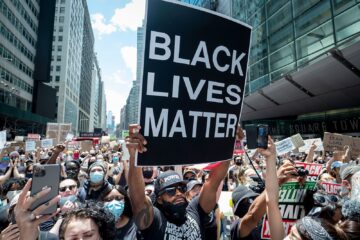 The novel engages with the contemporary racial justice movement Black Lives Matter. A pivotal scene in the novel – when the two couples hear about television images of a ‘cop kneeling on the guy’s neck’, leading to his ‘public […] asphyxiat[ion]’ – is a clear allusion to the murder of George Floyd on 25 May 2020, although the slain man’s name is never given. The subsequent global protests against police officer Derek Chauvin’s assumption he could kill a Black man with impunity are also elicited when Nicole speaks of ‘a curfew. People […] burning cop cars. […] An uprising’.
The novel engages with the contemporary racial justice movement Black Lives Matter. A pivotal scene in the novel – when the two couples hear about television images of a ‘cop kneeling on the guy’s neck’, leading to his ‘public […] asphyxiat[ion]’ – is a clear allusion to the murder of George Floyd on 25 May 2020, although the slain man’s name is never given. The subsequent global protests against police officer Derek Chauvin’s assumption he could kill a Black man with impunity are also elicited when Nicole speaks of ‘a curfew. People […] burning cop cars. […] An uprising’.
This incendiary moment ought to be a catalyst for the protagonist to shake off his white upbringing and think more profoundly about issues of subjectivity, race, and justice. Nicole exhorts him to watch the video of Floyd struggling to breathe, a clip which Jay, influenced by Marshal, has dismissed as an internet phenomenon. With exasperated understatement, she tells Jay: ‘Well, maybe you should. Maybe you should see it’. Disgusted by Marshal’s sceptical reaction to the footage and his keenness that Rob should do a portrait of her naked body, Nicole prepares to break up with her boyfriend. It is less clear whether our unreliable narrator will wake up to systemic racism, but the novel still conveys the urgency of BLM.
Blue Ruin is an intangible but resonant exploration of the pandemic era, through broad brushwork conveying unforgettable impressions of social class, race, and embodiment in the pandemic and beyond. Kunzru’s wry composition offers readers a glimpse of some of the social and personal upheavals to define recent and upcoming years.
Conclusion
Across the trilogy, Kunzru examines right-wing record collectors, the alt-right, and anti-vaxxers from an outsider, ambivalent, and ironized perspective. These novels portray such characters as odious, enigmatic, or simply banal, as with Carter and his family in White Tears, Anton and his friends in Red Pill, and Marshal in Blue Ruin. Even so, in a world marked by the resurgence of far-right ideologies amid a kind of networked racism, Kunzru challenges us to grapple with the ethics of giving extremist voices a hearing. The politics of listening, as exemplified in these novels, demonstrates the importance of critical engagement, empathy, and understanding in an increasingly divided society. In sum, Kunzru reveals the power of radical listening when it comes to right-wing credos – but also the anger and pain this causes.
